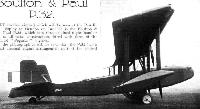
Flight, June 1932
Boulton & Paul P.32
YET another aircraft which will be seen at the R.A.F. Display at Hendon on June 25 is the Boulton & Paul P.32, which is a three-engined night bomber of all-metal construction, fitted with three of the new Bristol "Pegasus" engines.
From the photograph it will be seen that the P.32 has a somewhat unusual engine arrangement in that the central engine is not placed in the nose of the fuselage, but on the top centre-section. Of recent years there has been noticeable a tendency to avoid the nose engine in multi-engined aircraft. There are various reasons for this, chief among them being the fact that with the central engine removed from the nose of the fuselage, the cockpits can be so arranged as to give pilot and bomber a very much better view, making the aircraft the equal, in this respect, of a twin-engined machine. There was a time when certain doubts existed concerning the soundness of placing one or more engines so high above the centre of resistance, and types produced many years ago with this engine arrangement were far from being successful. However, the latest types of aeroplanes having engines on or near the top plane of a biplane have not shown any pronounced vices, and the arrangement is now accepted as quite a permissible one, while giving a number of advantages in other respects.
The Boulton & Paul P.32 is of the type of construction which this firm has developed during a long period of years, with high-tensile steel in the primary structure.
An undercarriage of the four-wheeled type is fitted, springing being by Boulton & Paul oleo-pneumatic shock-absorbing legs. Brakes are fitted on all four wheels, and as there is a castoring tail wheel, the machine is, what with outboard engines, remarkably manoeuvrable on the ground.
Great attention has been given to the control system of the P.32, and the machine is reported to be particularly light on the controls. The ailerons have Bristol-Frise balances, while elevators and rudders are servo-operated.
That the P. 32 is a large aircraft will be seen from the following figures - the only ones which it is permissible to publish at present.
The overall length is 47 ft. 6 in. and the wing span 100 ft. The height over the central engine is 22 ft., and the total wing area 2,090 sq. ft. As the gross weight is 22,700 lb., the wing loading becomes just under 11 lb./sq. ft., and the power loading (at 3 x 555 h.p.) 13.7 lb./h.p. The particular Bristol "Pegasus" engines fitted each develops 555 b.h.p. at 4,500 ft.
Описание:
- Flight, June 1932
Boulton & Paul P.32 - Flight, November 1932
British Aircraft
Фотографии
-
Aeroplane Monthly 1979-05 / P.Birtles - Troublesome Trimotors
Регистрационный номер: J9950 [6] J9950, the sole P.32 showing its unusual engine layout.
-
Aeroplane Monthly 1979-05 / P.Birtles - Troublesome Trimotors
Регистрационный номер: J9950 [6] A NEW NIGHT BOMBER: The Boulton &. Paul "P.32" is fitted with three Bristol Pegasus engines.
Unlike the P.32, which is seen here at Hendon, the D.H.72 never made a public appearance -
Flight 1932-06 / Flight
Регистрационный номер: J9950 [6] THE BOULTON & PAUL P.32 NIGHT BOMBER: The Central "Pegasus" engine is mounted on the top centre section, with the result that the view for pilot and front gunner is excellent.
-
Aeroplane Monthly 1979-05 / P.Birtles - Troublesome Trimotors
Регистрационный номер: J9950 [6] Evident in this view of the P.32 are the slats on the upper wing leading edge.
-
Aeroplane Monthly 1979-05 / P.Birtles - Troublesome Trimotors
Регистрационный номер: J9950 [6] The Boulton and Paul P.32 had more curvaceous lines than its D.H. counterpart. Engine changes and consequent technical problems caused much delay.
-
Aeroplane Monthly 1979-05 / P.Birtles - Troublesome Trimotors
Регистрационный номер: J9950 [6] The Boulton and Paul P.32 flies past the spectators during the 1932 RAF Display at Hendon.
- Фотографии





